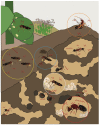Advances in the Study of Olfaction in Eusocial Ants
- PMID: 33802783
- PMCID: PMC8002415
- DOI: 10.3390/insects12030252
Advances in the Study of Olfaction in Eusocial Ants
Abstract
Over the past decade, spurred in part by the sequencing of the first ant genomes, there have been major advances in the field of olfactory myrmecology. With the discovery of a significant expansion of the odorant receptor gene family, considerable efforts have been directed toward understanding the olfactory basis of complex social behaviors in ant colonies. Here, we review recent pivotal studies that have begun to reveal insights into the development of the olfactory system as well as how olfactory stimuli are peripherally and centrally encoded. Despite significant biological and technical impediments, substantial progress has been achieved in the application of gene editing and other molecular techniques that notably distinguish the complex olfactory system of ants from other well-studied insect model systems, such as the fruit fly. In doing so, we hope to draw attention not only to these studies but also to critical knowledge gaps that will serve as a compass for future research endeavors.
Keywords: Formicidae; Hymenoptera; ants; eusocial; odor coding; olfaction; review.
Conflict of interest statement
The authors declare no conflict of interest. The funders had no role in the writing of the manuscript or in the decision to publish the results.
Figures


Similar articles
-
Age and Task Modulate Olfactory Sensitivity in the Florida Carpenter Ant Camponotus floridanus.bioRxiv [Preprint]. 2023 Jul 19:2023.07.18.549561. doi: 10.1101/2023.07.18.549561. bioRxiv. 2023. Update in: Insects. 2023 Aug 23;14(9):724. doi: 10.3390/insects14090724. PMID: 37503123 Free PMC article. Updated. Preprint.
-
Age and Task Modulate Olfactory Sensitivity in the Florida Carpenter Ant Camponotus floridanus.Insects. 2023 Aug 23;14(9):724. doi: 10.3390/insects14090724. Insects. 2023. PMID: 37754692 Free PMC article.
-
Olfactory pathway of the hornet Vespa velutina: New insights into the evolution of the hymenopteran antennal lobe.J Comp Neurol. 2016 Aug 1;524(11):2335-59. doi: 10.1002/cne.23975. Epub 2016 Mar 7. J Comp Neurol. 2016. PMID: 26850231
-
Insect olfaction: receptors, signal transduction, and behavior.Results Probl Cell Differ. 2009;47:121-38. doi: 10.1007/400_2008_10. Results Probl Cell Differ. 2009. PMID: 19083129 Review.
-
Olfactory Mechanisms for Discovery of Odorants to Reduce Insect-Host Contact.J Chem Ecol. 2016 Sep;42(9):919-930. doi: 10.1007/s10886-016-0770-3. Epub 2016 Sep 15. J Chem Ecol. 2016. PMID: 27628342 Free PMC article. Review.
Cited by
-
Influence of Host Plants and Tending Ants on the Cuticular Hydrocarbon Profile of a Generalist Myrmecophilous Caterpillar.J Chem Ecol. 2024 Jun;50(5-6):222-236. doi: 10.1007/s10886-024-01477-y. Epub 2024 May 15. J Chem Ecol. 2024. PMID: 38748380
-
Foraging by predatory ants: A review.Insect Sci. 2025 Aug;32(4):1096-1118. doi: 10.1111/1744-7917.13461. Epub 2024 Oct 21. Insect Sci. 2025. PMID: 39434405 Free PMC article. Review.
-
Identification, expression profiles, and binding properties of chemosensory protein 18 in Plutella xylostella (Lepidoptera: Plutellidae).J Insect Sci. 2024 Jan 1;24(1):3. doi: 10.1093/jisesa/ieae002. J Insect Sci. 2024. PMID: 38297809 Free PMC article.
-
Ancestral complexity and constrained diversification of the ant olfactory system.Proc Biol Sci. 2025 Apr;292(2045):20250662. doi: 10.1098/rspb.2025.0662. Epub 2025 Apr 30. Proc Biol Sci. 2025. PMID: 40300630 Free PMC article.
-
Genome-Wide Analysis of the Odorant Receptor Gene Family in Solenopsis invicta, Ooceraea biroi, and Monomorium pharaonis (Hymenoptera: Formicidae).Int J Mol Sci. 2023 Apr 1;24(7):6624. doi: 10.3390/ijms24076624. Int J Mol Sci. 2023. PMID: 37047591 Free PMC article.
References
-
- Hölldobler B., Wilson E.O. The Ants. Belknap Press of Harvard University Press; Cambridge, MA, USA: 1990. p. 732.
-
- Weber N.A. Gardening Ants, the Attines. American Philosophical Society; Philadelphia, PA, USA: 1972. p. 146.
-
- Kronauer D.J.C. Army Ants: Nature’s Ultimate Social Hunters. Harvard University Press; Cambridge, MA, USA: 2020. p. 384.
-
- Pratt S.C., Mallon E.B., Sumpter D.J., Franks N.R. Quorum sensing, recruitment, and collective decision-making during colony emigration by the ant Leptothorax albipennis. Behav. Ecol. Sociobiol. 2002;52:117–127. doi: 10.1007/s00265-002-0487-x. - DOI
-
- Ferguson S.T., Anand A., Zwiebel J. Olfactory genomics of eusociality within the Hymenoptera. In: Blomquist G.J., Vogt R.G., editors. Insect Pheromone Biochemistry and Molecular Biology. 2nd ed. Elsevier; Cambridge, MA, USA: 2020. pp. 507–546.
Publication types
Grants and funding
LinkOut - more resources
Full Text Sources
Other Literature Sources
Miscellaneous

